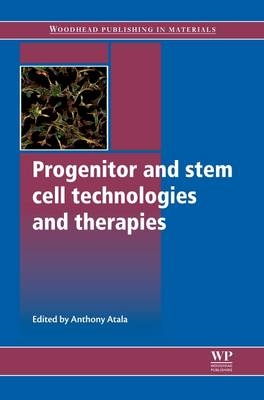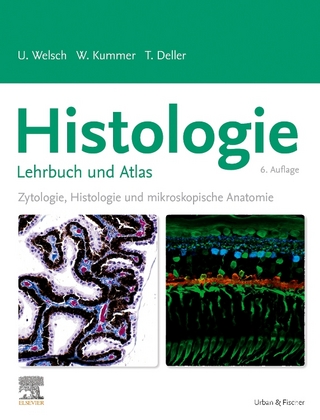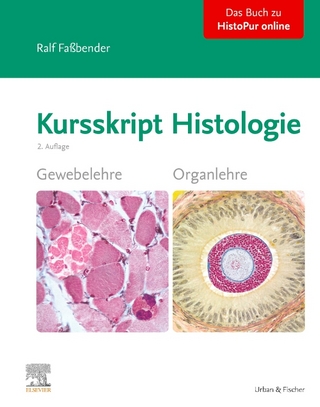
Progenitor and Stem Cell Technologies and Therapies
Woodhead Publishing Ltd (Verlag)
978-1-84569-984-0 (ISBN)
- Titel ist leider vergriffen;
keine Neuauflage - Artikel merken
Progenitor and stem cells have the ability to renew themselves and change into a variety of specialised types, making them ideal materials for therapy and regenerative medicine. Progenitor and stem cell technologies and therapies reviews the range of progenitor and stem cells available and their therapeutic application.Part one reviews basic principles for the culture of stem cells before discussing technologies for particular cell types. These include human embryonic, induced pluripotent, amniotic and placental, cord and multipotent stem cells. Part two discusses wider issues such as intellectual property, regulation and commercialisation of stem cell technologies and therapies. The final part of the book considers the therapeutic use of stem and progenitor cells. Chapters review the use of adipose tissue-derived stem cells, umbilical cord blood (UCB) stem cells, bone marrow, auditory and oral cavity stem cells. Other chapters cover the use of stem cells in therapies in various clinical areas, including lung, cartilage, urologic, nerve and cardiac repair.With its distinguished editor and international team of contributors, Progenitor and stem cell technologies and therapies is a standard reference for both those researching in cell and tissue biology and engineering as well as medical practitioners investigating the therapeutic use of this important technology.
Anthony Atala, M.D., is the Director of the Wake Forest Institute for Regenerative Medicine, and the W.H. Boyce Professor and Chair of the Department of Urology at Wake Forest University. Dr. Atala is a practicing surgeon and a researcher in the area of regenerative medicine. His current work focuses on growing new human cells, tissues and organs. Dr. Atala works with several journals and serves in various roles, including Editor-in-Chief of Current Stem Cell Research and Therapy, and Therapeutic Advances in Urology; as Associate Editor of the Journal of Tissue Engineering and Regenerative Medicine, The Journal of Rejuvenation Research, Nanotechnology in Engineering and Medicine, Gene Therapy and Regulation, and Current Reviews in Urology; as Executive Board Member or Section Editor of the journal Tissue Engineering and International Journal of Artificial Organs, and as Editorial Board member of the International Journal of Stem Cells, Stem Cell Review Letters, Expert Opinion on Biological Therapy, Biomedical Materials, Recent Patents on Regenerative Medicine, the Journal of the American College of Surgeons, the Journal of Urology, BMC Urology, Urology, and Current Opinion in Urology. Dr. Atala is a recipient of the US Congress funded Christopher Columbus Foundation Award, bestowed on a living American who is currently working on a discovery that will significantly affect society, and the Gold Cystoscope Award for advances in his field. Dr. Atala was named by Scientific American as a Medical Treatments Leader of the Year for his contributions to the fields of cell, tissue and organ regeneration. In 2006, he was named by Fast Company magazine as one of 50 people who “will change how we work and live over the next 10 years. Dr. Atala’s work was listed as Discover Magazine`s Number 1 Top Science Story of the Year in the field of medicine, and as Time Magazine’s top 10 medical breakthroughs of the year in 2007. A Time Magazine poll ranked Dr. Atala as the 56th most influential person of the year in 2007. Esquire Magazine in 2008 named Dr. Atala one of the 75 most influential persons of the 21st century. Fast Company Magazine named Dr. Atala one of 100 Most Creative People in Business in 2009. Dr. Atala was featured in U.S. News & World Report as one of “14 Medical Pioneers Who Aren’t Holding Back. Dr. Atala has led or served several national professional and government committees, including the National Institutes of Health working group on Cells and Developmental Biology, and the National Institutes of Health Bioengineering Consortium. He is currently an NIH “Quantum Grant awardee. Dr. Atala heads a team of over 250 physicians and researchers. Ten applications of technologies developed in Dr. Atala's laboratory have been used clinically. He is the editor of nine books, including Minimally Invasive Urology, Methods of Tissue Engineering, Principles of Regenerative Medicine, and Foundations of Regenerative Medicine, and has published more than 300 journal articles and has applied for or received over 200 national and international patents.
Dedication
Contributor contact details
Introduction
Part I: Basic principles of stem cells
Chapter 1: Basic principles for stem cell culture
Abstract:
1.1 Introduction
1.2 Understanding and standardization of in vitro culture systems
1.3 Quality assurance
1.4 Documentation
1.5 Safety
1.6 Legal, ethical and regulatory compliance
1.7 Education and training
1.8 Conclusion
1.9 Acknowledgement
Chapter 2: Basic principles of human embryonic stem cells
Abstract:
2.1 Introduction: biological properties of human embryonic stem cells (hESC)
2.2 Historical overview
2.3 Human embryonic stem cells (hESC) in therapy – current status and strategies for the future
2.4 Human embryonic stem cells (hESC) in drug discovery – current status and strategies for the future
2.5 Specific mutation-carrying (SMC) human embryonic stem cells (hESC)
2.6 Human embryonic stem cells (hESC) utilization, the next step
2.7 Conclusion
Chapter 3: Basic principles in generating induced pluripotent stem cells
Abstract:
3.1 Introduction
3.2 Evolution of reprogramming and the birth of induced pluripotency
3.3 Current methods for induced reprogramming
3.4 Conclusions and future prospects
Chapter 4: Basic principles of amniotic fluid and placenta stem cells
Abstract:
4.1 Introduction
4.2 Amniotic fluid and placenta in developmental biology
4.3 Isolation and characterization of progenitor cells
4.4 Differentiation of amniotic fluid- and placenta-derived progenitor cells
4.5 In vivo behavior of amniotic fluid stem cells
4.6 Amniotic fluid and placenta for cell therapy
4.7 Conclusion
4.8 Acknowledgment
Chapter 5: Basic principles of cord blood stem cells
Abstract:
5.1 Introduction: history of cord blood stem cell technology
5.2 Cord blood collection, processing and storage
5.3 Public and private cord blood banking
5.4 Cord blood haemopoietic stem cell transplantation
5.5 Cord blood mesenchymal stem cells
5.6 Current research and future developments
5.7 Cord blood transfusion
5.8 Conclusion
Chapter 6: Basic principles of multipotent stem cells
Abstract:
6.1 Introduction
6.2 Hematopoietic stem cells (HSC)
6.3 Mesenchymal stem cells (MSC)
6.4 Adult stem cells with broader potential
6.5 In vitro and in vivo differentiation potential of multipotent adult progenitor cells (MAPC)
6.6 Immunomodulatory properties of multipotent adult progenitor cells (MAPC)
6.7 Conclusion
Part II: Enabling cell therapy
Chapter 7: Intellectual property claims to stem cell technologies: research, clinical testing and product sales
Abstract:
7.1 Introduction
7.2 International overview of patent laws and stem cell policies
7.3 Introduction to the international stem cell patent landscape
7.4 Human embryonic stem cell patents
7.5 Advances in induced pluripotent stem cell patents (iPS cells)
7.6 Models for access to, and management of, stem cell patents
7.7 Conclusion
7.8 Acknowledgments
Chapter 8: Regulatory considerations of stem and progenitor cell-based products: US Food and Drug Administration
Abstract:
8.1 Introduction
8.2 Preparing the cellular component: chemistry, manufacturing and control considerations
8.3 Preclinical testing: pharmacology/toxicology considerations
8.4 Clinical trial considerations
8.5 Combination products: considerations when combining stem/progenitor cells with other components
8.6 Conclusion and future regulatory tools development
8.7 Acknowledgments
Chapter 9: Cell therapy commercialisation
Abstract:
9.1 Introduction: cells as therapies
9.2 The field to date
9.3 Commercialisation
9.4 Manufacturing
9.5 Future trends
9.6 Conclusion
9.7 Acknowledgements
9.8 Sources of further information
Chapter 10: Stem cell tourism
Abstract:
10.1 Introduction
10.2 Scope of the phenomenon
10.3 Problems relating to stem cell tourism
10.4 Responses
10.5 Conclusion
10.6 Acknowledgments
Part III: Tissue-specific progenitor cells
Chapter 11: Adipose tissue-derived stem cell biology and therapy
Abstract:
11.1 Introduction
11.2 Characterization of adipose tissue-derived stromal cells
11.3 Advantages of adipose tissue-derived stem cells over other cell sources
11.4 Adipose tissue-derived stromal cells for cardiovascular repair: a joint clinical and experimental approach
11.5 Conclusion: perspectives and open questions
11.6 Acknowledgements
Chapter 12: Umbilical cord blood (UCB) progenitor and stem cell biology and therapy
Abstract:
12.1 Introduction
12.2 Biological characterization of umbilical cord blood (UCB) stem/progenitor cells
12.3 Therapeutic potential of umbilical cord blood (UCB) stem/progenitor cells for tissue repair or regeneration
12.4 Conclusion and future perspectives
Chapter 13: Auditory progenitor stem cell biology and therapy
Abstract:
13.1 Introduction
13.2 Sources of auditory progenitors
13.3 Transdifferentiation or developmental progression?
13.4 Which is the best cell type and stage for transplantation?
13.5 Future trends
Chapter 14: Olfactory mucosa: neural stem and progenitor cells for nervous system repair and cell models of brain disease
Abstract:
14.1 Introduction
14.2 Olfactory mucosa as source of tissue-resident stem cells
14.3 Cells with clinical application
14.4 Preclinical and clinical studies
14.5 Olfactory stem cell models of human disease
14.6 Conclusion
14.7 Acknowledgements
Chapter 15: Oral cavity progenitor and stem cell biology and therapy
Abstract:
15.1 Introduction
15.2 Embryonic development of teeth and supporting tissues
15.3 Tooth bud-derived stem cell types and differentiation potential
15.4 Stem cells present in postnatal teeth
15.5 Unsolved problems in the use of dental stem cells
15.6 Conclusion
Chapter 16: Bone marrow mesenchymal progenitor and stem cell biology and therapy
Abstract:
16.1 Introduction
16.2 Mesenchymal stem cell (MSC) biology
16.3 Mesenchymal stem cell (MSC) therapy
16.4 Conclusion
Chapter 17: Progenitor and stem cell therapies for cartilage repair
Abstract:
17.1 Introduction
17.2 Cell-based therapies for cartilage repair
17.3 Tissue engineering strategies for cartilage repair
17.4 Hurdles for cartilage tissue regeneration
17.5 Conclusion and future trends
17.6 Acknowledgement
Chapter 18: Cardiac stem and progenitor cell biology and therapy
Abstract:
18.1 Introduction: current concept of cardiac tissue homeostasis
18.2 From none to plenty: cardiac stem/progenitor cell populations within adult myocardium
18.3 Origin of cardiac stem cells in the adult human heart
18.4 Cardiac stem cell niche
18.5 Regeneration boosting
18.6 Conclusions
Chapter 19: Renal progenitor and stem cell biology and therapy
Abstract:
19.1 Introduction
19.2 Endogenous renal progenitor cells and regeneration
19.3 Summary and conclusions
Chapter 20: Lung progenitor and stem cell biology and therapy
Abstract:
20.1 Introduction: definitions of a diverse population
20.2 Lung development and stem cell zones
20.3 Resident lung stem cells and their niches
20.4 Circulating bone marrow-derived stem cells which home to the lung
20.5 Techniques for identification of lung stem cells
20.6 Disorders of lung stem cells and clinical applications in lung diseases
20.7 Induced pluripotent stem cells (iPSCs)
20.8 Conclusion: future directions for lung stem cells through bioengineered lung tissue
20.9 Acknowledgments
Chapter 21: Genitourinary progenitor and stem cell biology and therapy
Abstract:
21.1 Introduction
21.2 The basics of tissue engineering
21.3 Cells for use in urological tissue engineering
21.4 Biomaterials for urological tissue engineering
21.5 Tissue engineering of specific urologic structures
21.6 Conclusion
21.7 Acknowledgments
Index
| Reihe/Serie | Woodhead Publishing Series in Biomaterials |
|---|---|
| Verlagsort | Cambridge |
| Sprache | englisch |
| Maße | 156 x 234 mm |
| Gewicht | 1000 g |
| Themenwelt | Medizin / Pharmazie ► Physiotherapie / Ergotherapie ► Orthopädie |
| Studium ► 1. Studienabschnitt (Vorklinik) ► Histologie / Embryologie | |
| Technik ► Maschinenbau | |
| Technik ► Medizintechnik | |
| ISBN-10 | 1-84569-984-X / 184569984X |
| ISBN-13 | 978-1-84569-984-0 / 9781845699840 |
| Zustand | Neuware |
| Haben Sie eine Frage zum Produkt? |
aus dem Bereich


